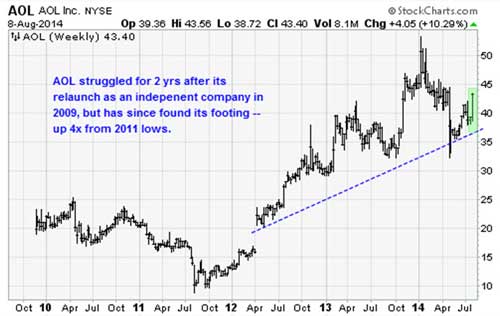 |
Some good earnings news emerged last week from fallen dot-com star AOL (AOL), which reported a top- and bottom-line beat for the second quarter as well as announced a $150 million buyback program thanks to a 20 percent increase in ad revenue. Shares gained nearly 8 percent as a result.
Before Amazon.com, before Yahoo!, before Google, before even the term “dot-com” was invented, there was AOL, sending out tens of millions of CDs in the first viral marketing campaign to get Americans hooked up to its white-washed version of what we now know as the Internet. Many readers may be too young to remember, but AOL literally was the Internet for most tech-savvy people in the mid-1990s, though now we would probably call its service an app.
It was responsible for an amazing number of innovations that linger to this day, including the first mass-market consumer email (“You’ve got mail!”); instant messaging (AIM); and stock market blogs and discussion boards (Motley Fool). AOL.com shares were one of the top three gainers of the 1990s, up more than 50,000 percent in 10 years, surpassed only by the likes of EMC (EMC) and the now private Dell Computer.
The AOL brand was ruined after its merger with Time-Warner in one of the most disastrous, value-destroying M&A deals of all time. But after about a decade in the doghouse it appears to be getting back on track as an independent entity, headlined by its Huffington Post unit. AOL is still as cheesy as ever, but I think we like it that way. Good to see this pioneer enjoying success again.
Interesting to note amid the numbers was the still-high level of dial-up users. At the end of June, it had 2.3 million subscribers. In fact, it makes most of its money from these people, whoever they are. AOL didn’t break down the numbers specifically. But it seems that old habits die hard — it said that the average subscriber has been with the company for 14 years. Those subscribers are paying $20.86 a month for the service.
Still, the future is questionable for this revenue stream. For the quarter, it said that subscription revenue declined 7 percent to $155 million and it had about 9 percent fewer subscribers than at the beginning of the period. And the total is down from 3.5 million subscribers it had in 2011.
Many publications, including the Washington Post, wondered out loud whether some of these dial-up users could just be people who forgot to cancel their subscriptions years ago. So, perhaps we should all be double-checking our credit-card bills for some legacy charges.
Meanwhile, as I told my New Technology Superstars members recently, this is still a great environment for tech investors as software, networks and chips remain the key routes for companies and countries to pull themselves forward efficiently and productively.
We have taken profits on a few of our positions lately, but have also bought a couple of new ones opportunistically. I expect to have one or two new recommendations in the coming week.
Best wishes,
Jon Markman

